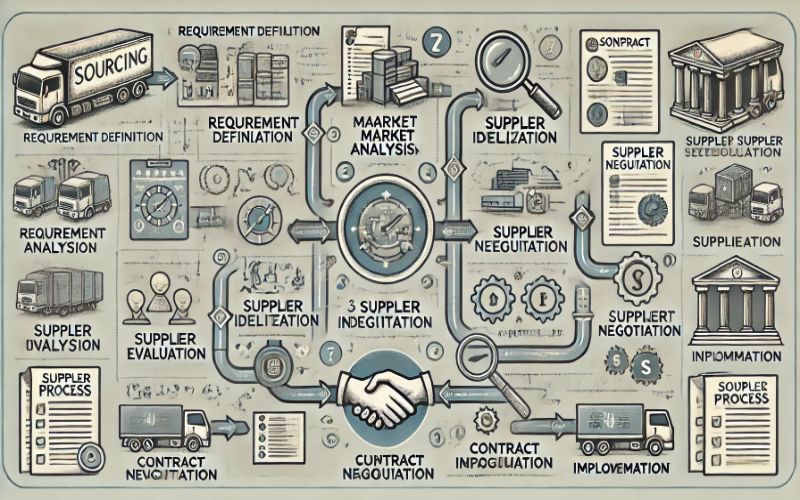Sep 4
Real Estate: 7-Step Strategic Sourcing Process And Benefits
Engaging in the 7-step strategic sourcing process in real estate sets your organization up for success. This systematic approach allows you to address sourcing needs effectively while optimizing supplier relationships. Throughout this process, you'll identify key focus areas, create profiles for better understanding, and analyze supply markets to make well-informed decisions.
By developing tailored strategies and selecting the most suitable sourcing processes, you ensure that you are well-prepared for effective supplier negotiations. Moreover, actively managing these relationships can yield long-term value and foster innovation. Are you curious about how each step contributes to cost savings and competitive advantages? Let’s delve deeper into this structured 7-step approach with Strategic Success Consulting.
What Is Strategic Sourcing?
Strategic sourcing entails a comprehensive approach to procurement, emphasizing the optimization of organizational purchasing practices. The primary goals of sourcing strategy include achieving cost efficiencies, streamlining procurement operations, enhancing supplier performance, and managing risks. In contrast to conventional methods focused on immediate cost reductions, strategic sourcing aims to cultivate enduring, collaborative supplier relationships that yield mutual advantages over time.
At the core of strategic sourcing is a proactive and systematic procurement strategy, fostering partnerships with key suppliers to innovate and improve product and service quality. In turn, these suppliers anticipate a commitment to enduring partnerships, fostering collective growth and shared success. This approach is particularly advantageous in sectors like real estate, where sustained investments and stable supplier relationships are essential.
What Is The Objective Of The Sourcing Process?
The objectives of a sourcing process can differ between businesses based on their unique needs and strategic priorities. However, there are common goals that most enterprises strive to achieve through their sourcing strategies. These include:
- Enhancing operational efficiency
- Accelerating time-to-market
- Reducing exposure to risks
- Addressing and resolving business challenges
- Controlling and reducing procurement costs
- Ensuring adherence to industry regulations
- Fostering healthy competition
These objectives are designed to align with the enterprise's broader strategic goals and improve overall performance.
The 7 Steps Of The Sourcing Process
A well-structured sourcing process is the backbone of effective procurement in real estate, enabling organizations to navigate complex markets and make informed decisions. By following these steps, you can uncover valuable insights, assess your needs, and develop targeted strategies that not only enhance operational efficiency but also drive long-term success.

Identify Sourcing Needs
To effectively identify sourcing needs, you must assess your current property requirements and strategic planning. Start by understanding properties' specific needs, such as size, location, amenities, and budget constraints. This foundational step is pivotal in the Strategic Sourcing Process and will guide you in making informed decisions.
- First, conduct a detailed analysis of your property's current usage. Examine occupancy rates, market trends, and tenant requirements to ensure your sourcing aligns with business objectives and long-term growth strategies. This analysis will help pinpoint your organization's needs, making the process more efficient.
- Next, prepare a detailed Request for Proposal (RFP). This RFP document should outline your specific needs and expectations. Clearly defining these elements in your RFP will streamline communication with potential property providers, ensuring they understand your requirements and can offer suitable solutions.
Profile Categories
Now that you've identified your sourcing needs, it's time to profile property categories to streamline your strategic sourcing process. Start by categorizing properties into residential, commercial, industrial, and agricultural. This initial classification helps you tailor your approach and use the right procurement software for each type.
Next, quantify the sizes of the properties, considering square footage for buildings and acreage for land. This step is essential for effective sourcing and allows you to compare properties accurately within the same category. To ensure your profiles are precise, distinguish between single-family homes, office buildings, warehouses, and farmlands. Remember to analyze the volumes of real estate transactions within each category.
Analyze Supply Markets
Analyzing supply markets gives you a comprehensive understanding of the vendors, market competitors, and trends that shape your real estate landscape. Deep supply market analysis can identify potential risks and opportunities that might impact your sourcing strategy. Understanding the market dynamics, such as pricing trends and demand-supply fluctuations, helps you make informed and successful business decisions.
When you analyze the supply market, you'll uncover critical information about cost drivers and potential savings. For example, scrutinizing labor fees, transportation costs, and supplier capabilities can reveal areas where you can optimize expenses. This detailed insight lets you pinpoint strategic sourcing opportunities, enhancing your competitive advantage.
Furthermore, conducting a market analysis of the supply industry gives you the expertise to negotiate advantageous terms with suppliers. By staying up-to-date about emerging technologies and advancements in the real estate sector, you can proactively position yourself and capitalize on these developments to your advantage.
Develop Strategies
Leveraging insights derived from supply market analyses is imperative to effectively formulate real estate sourcing strategies aligned with your investment objectives. Begin by discerning the property types—residential, commercial, industrial, or mixed-use—that resonate with your business aspirations and risk tolerance. This crucial step ensures the alignment of your investments with financial targets and prevailing market dynamics.
Subsequently, it is essential to factor in key determinants that impact property valuation, including location, property condition, rental yields, and potential for appreciation. These considerations aid in prioritizing properties that offer optimal cost-efficiency and long-term growth prospects. For example, properties in burgeoning neighborhoods often hold significant potential for appreciation, while well-maintained properties can mitigate repair expenses.
Furthermore, engaging with real estate professionals, brokers, and industry specialists is pivotal. Their expertise provides valuable insights into market trends and facilitates well-informed decision-making.
Select Sourcing Processes
Evaluating potential vendors based on their qualifications and capabilities is vital for selecting effective sourcing processes in real estate. You must identify vendors meeting your sourcing strategy's requirements and goals.
Start by appraising their track record, financial stability, and ability to deliver on time. This will ensure you choose suppliers with the best value propositions and competitive pricing.
Implementing best practices during this phase is essential. Conduct thorough market research to shortlist vendors with a proven history of success in similar real estate projects. Use a scoring system to objectively compare potential suppliers based on key criteria, such as quality, cost, and service levels. This structured approach helps you make informed decisions and reduces the risk of selecting unsuitable vendors.
Negotiate With Suppliers
Negotiating with suppliers is an important step in the real estate strategic sourcing process that can greatly impact your project's success. By effectively discussing financial terms and conditions, you can secure cost savings and improve the quality of your product or service.

- Initial negotiations often focus on pricing but pay attention to other vital elements like delivery schedules, payment terms, and contract length. Suppliers might offer discounts, extended payment terms, or value-added services to sweeten the deal.
- Consider skilled negotiation tactics like bundling services or seeking volume discounts to maximize benefits. Bundling multiple products or services into a single contract can significantly reduce costs. Volume discounts can also be advantageous, especially if planning large-scale projects requiring substantial materials or services.
- Long-term partnerships often yield better financial terms and conditions, as suppliers value the promise of ongoing business.
- Effective negotiation saves money, strengthens supplier relationships, and improves project efficiencies. By securing favorable terms, you set the stage for smoother project execution and enhanced overall outcomes.
Keep your goals clear and negotiate assertively to ensure your real estate projects benefit from the best possible supplier agreements.
Manage Supplier Relationships
After securing favorable terms through effective negotiation, the next step is actively managing supplier relationships to guarantee smooth project execution and long-term success. Effective supplier relationship management involves fostering open communication, resolving conflicts swiftly, and building trust to establish long-term partnerships. Nurturing these relationships can mitigate risks, uphold quality standards, and promote innovation in real estate projects.
One critical aspect of managing supplier relationships is conducting regular performance evaluations. These evaluations, coupled with feedback mechanisms, make sure that suppliers meet and exceed your expectations. Consistent collaboration is also crucial, allowing you to address issues proactively and work towards shared goals.
Developing mutually beneficial agreements and setting clear expectations from the outset are essential to align your objectives with those of your suppliers.
Effective supplier relationship management strategy enhances efficiency, reduces costs, and creates value in real estate ventures. You can create an environment where both parties thrive by aligning goals and fostering open communication.
Benefits Of The 7-Step Strategic Sourcing Process
Implementing the 7-step strategic sourcing process can transform an organization’s approach to procurement, unlocking a wealth of benefits that extend far beyond simple cost savings. This comprehensive methodology not only streamlines procurement operations but also fosters stronger supplier partnerships, enhances operational efficiency, and drives innovation.
Let's delve into the key advantages of this strategic approach and how it can elevate your procurement practices to new heights:
Enhanced Cost Savings
By analyzing the market trend deeply and negotiating with suppliers, your organizations can secure much better pricing and terms, which leads to substantial savings. These are not just short-term cost reductions; they can contribute to the long-term financial health of your business and allow for reinvestment in other critical business areas.
Stronger Supplier Collaboration
Another noticeable advantage is the fostering of stronger supplier collaboration. The strategic sourcing process involves building long-term supplier relationships based on mutual benefit and trust. This collaboration leads to excellent quality of goods and services, as suppliers are more invested in maintaining high standards to continue their partnership. Supplier relationships also increase business efficiency, as both parties work together to streamline processes and resolve any issues and risks that arise quickly and effectively. This results in a more reliable and responsive supply chain.
Operational Excellence
Another key benefit of strategic sourcing is operational excellence. By implementing a systematic approach to procurement, organizations can ensure they receive the best possible value for their investments. This includes cost savings and obtaining high-quality products and services that meet or exceed specifications.
Transform Your Real Estate Procurement with Strategic Sourcing
In conclusion, the 7-step strategic sourcing process is not just a framework—it's a game-changer for organizations in the real estate sector. By adopting this structured approach, businesses can navigate the complexities of procurement with confidence, ensuring that every decision is data-driven and aligned with their strategic goals. Each step—from identifying sourcing needs to managing supplier relationships—plays a crucial role in enhancing operational efficiency, driving innovation, and fostering lasting partnerships.
Unlock valuable insights and take your real estate investing game to the next level by signing up for FREE with Strategic Success Consulting!
COACHING
Service is at the heart of everything we do at Strategic Success Consulting. You'll experience the difference when you talk to our associates, and you'll see the difference that exceptional makes in your learning journey. Book a Discovery Call for more information!
COURSES
We offer Strategies, Courses, Modules and Deep Dives to help support you throughout your business or real estate investing journey.
EVENTS
Come check out our Strategic Entrepreneur Networking events in person or online! We also host webinars, workshops and other events that you can find on our events calendar!
ABOUT US
At Strategic Success Consulting we uphold an ongoing commitment to providing an elevated level of personal service. Our clients come first, and as a result, they are able to achieve more than they ever dreamed with their business and/or real estate investing.
Copyright © 2024 Strategic Success Consulting Inc. All rights reserved.
